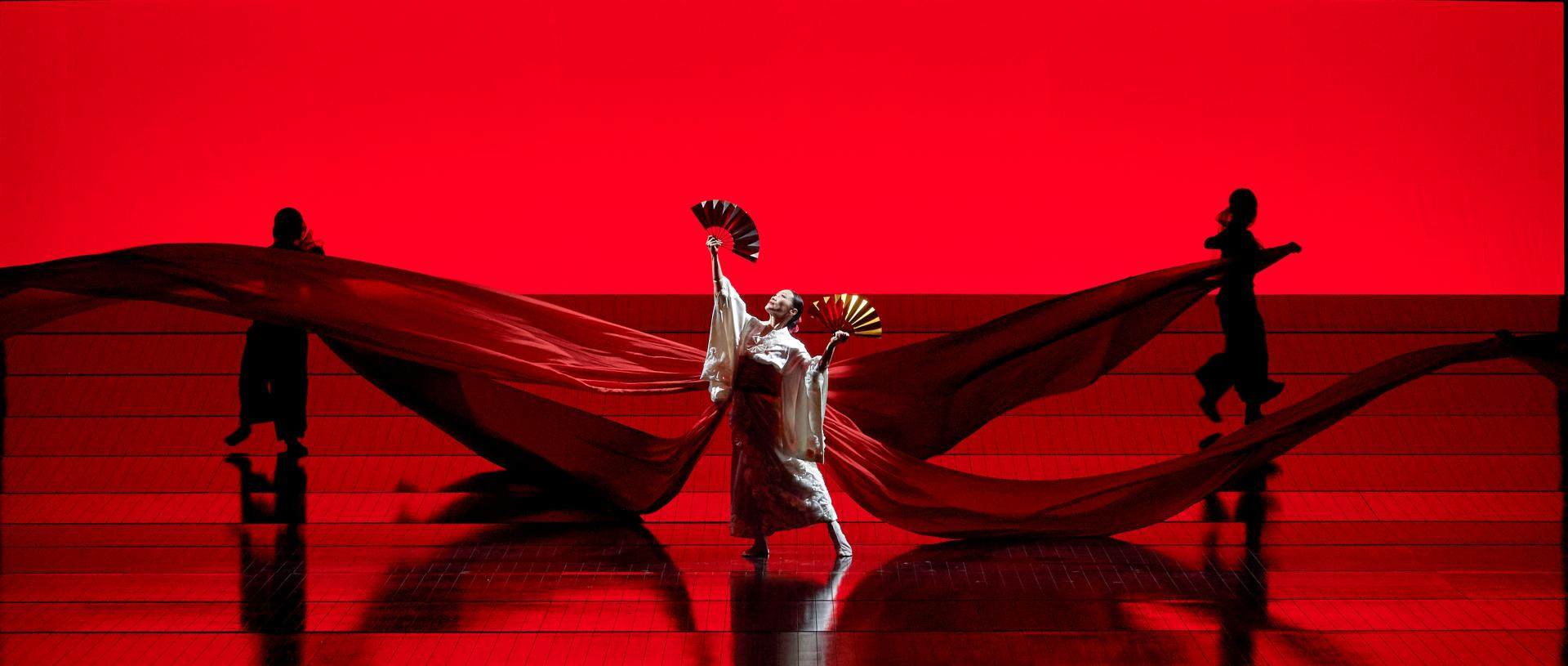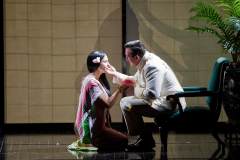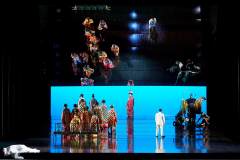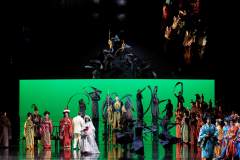Madama Butterfly
November 2024 | ||||||
|---|---|---|---|---|---|---|
Mo | Tu | We | Th | Fr | Sa | Su |
ACT 1
On a hill overlooking Nagasaki, the American naval lieutenant Benjamin Franklin Pinkerton visits a house and servants that the matchmaker Goro has organized for him.
This is where he will spend his honeymoon with his future wife Cio-Cio-San, known as "Butterfly". The contract for the house and wife runs for 999 years, but can be terminated by the American on a monthly basis. The first wedding guest is the American consul Sharpless. Pinkerton raves to him about his no-strings-attached marriage; Sharpless, on the other hand, has been made aware of Cio-Cio-San's voice during her visit to the consulate the day before: He warns his compatriot not to make this woman unhappy. Pinkerton toasts with him to the day when he will enter into "a real marriage" with an American woman.
Butterfly arrives at the house with her friends. In conversation with Sharpless and Pinkerton, she tells them that her once wealthy family became impoverished after the death of her father, forcing her to work as a geisha. In the meantime, Butterfly's relatives have arrived and are making secret judgments about the bridegroom. Butterfly shows Pinkerton the personal belongings she has brought with her, including an object she is reluctant to talk about: the dagger with which her father committed suicide on the Emperor's orders. She tells Pinkerton that she has secretly adopted his religion so that she can share his life completely.
The imperial commissioner presents the marriage contract in the presence of a registrar, the bride and groom sign it and the marriage is concluded; the official guests leave the party. Pinkerton, who finds Butterfly's "hired" relatives a nuisance, wants to get the family celebration over with quickly when Butterfly's uncle, a Buddhist priest, storms in. He curses Butterfly for her change of religion, whereupon her whole family disowns her. Pinkerton throws the guests out and is left alone with his weeping wife. Full of anticipation for the wedding night, he comforts his "plaything". Pinkerton's words convince Butterfly that he will compensate her for the loss of her family. They spend their first night together.
ACT 2, PART 1
Pinkerton's departure from Japan was three years ago. His and Cio-Cio-San's child, a blond, blue-eyed boy, was born after his departure.
Cio-Cio-San, the child and the servant Suzuki still live in the house on the hill, as Pinkerton has the consul pay the monthly rent, but the money for their living expenses is almost exhausted. Suzuki doubts that Pinkerton will return, but Cio-Cio-San paints the day of his arrival in bright colors for her and herself.
Consul Sharpless visits Butterfly. He wants to read her a letter from Pinkerton concerning her. They are interrupted by Goro, who since Pinkerton's departure has regularly tried to find Cio-Cio-San a new husband, which she consistently refuses. Lord Yamadori, the most persistent of the new marriage candidates, pays his respects to her again. Cio-Cio-San, trusting in binding American marriage law, continues to insist on being addressed as "Madama B. F. Pinkerton" and dismisses him demonstratively. Sharpless' reading of the letter repeatedly interrupts Cio-Cio-San with expressions of her delight, so that the main part of the letter remains unread. Given her blindness to the obvious, Sharpless impatiently asks her what she will do if Pinkerton never returns. She has two options, says Cio-Cio-San: to resume her service as a geisha or to die.
When Sharpless tries to persuade her not to refuse Yamadori's hand, Cio-Cio-San triumphantly presents him with the child, which she sees as a guarantee of Pinkerton's return. Sharpless promises to inform Pinkerton of the child's existence. He has barely left when a cannon shot announces the arrival of an American warship in the harbor: Pinkerton's ship! Cio-Cio-San is euphorically triumphant and instructs Suzuki to pick all the flowers in the garden and decorate the house with them. She adorns herself with her wedding dress, then waits for Pinkerton with Suzuki and the child. Night falls.
ACT 2, PART 2
In the morning, Pinkerton still hasn't arrived.
Only when Cio-Cio-San retires with the child to rest does Sharpless sneak into the house with him and ask Suzuki for help: she is to convince Cio-Cio-San to hand the child over to Pinkerton and his American wife Kate, who has traveled with him and is waiting in the garden.
Pinkerton is overwhelmed by his feelings of guilt and avoids a confrontation, while Kate assures herself of Suzuki's support. Suzuki and Sharpless make it clear to Cio-Cio-San in a few words that Pinkerton has not returned for her sake, but to pick up the child.
Cio-Cio-San declares that she will only hand over her son to Pinkerton personally. Left alone, she prepares to kill herself with her father's dagger. She blindfolds the child sent to her by Suzuki before stabbing herself. Pinkerton finds her dying.
ACT 1 - 55 MIN
INTERMISSION - 25 MIN
ACT 2 - 85 MIN
Program and cast
Cio-Cio-San: Marina Rebeka
Suzuki: Daria Sushkova
Kate Pinkerton: Anita Monserrat
Pinkerton: Joshua Guerrero
Sharpless: Stefan Astakhov
Musical Direction: Giampaolo Bisanti
Direction: Anthony Minghella
Direction and Choreography: Carolyn Choa
Stage: Michael Levine
Costumes: Han Feng
Lighting: Peter Mumford
Puppet Design and Direction: Blind Summit Theatre Mark Down & Nick Barnes
Vienna State Opera
Public Transport
Subway lines: U1, U2, U4
Trams: 1, 2, D, J, 62, 65
Buses: 59A
Local Railway: Badner Bahn
Stops: Karlsplatz / Opera
Taxi stands are available nearby.
Parking
Parking is only € 6, - for eight hours!
The Wiener Staatsoper and the ÖPARK Kärntner Ring Garage on Mahlerstraße 8, under the “Ringstraßengalerien”, offer the patrons of the Vienna State Opera a new, reduced parking fee. You can park in the Kärntner Ring Garage for up to 8 hours and pay only a flat fee of € 6, -. Just validate your ticket at one of the discount machines inside the Wiener Staatsoper. The normal rate will be charged for parking time greater than 8 hours. The validation machines can be found at the following coat checks: Operngasse, Herbert von Karajan-Platz, and the right and left and balcony galleries.
Important: In order to get the discount, please draw a ticket and do not use your credit card when entering the garage!
After devaluing your ticket in the Wiener Staatsoper you can pay comfortably by credit card or cash at the vending machines.
The machines accept coins and bills up to 50.- Euro. Parking time longer than 8 hours will be charged at the normal rate.
History
The structure of the opera house was planned by the Viennese architect August Sicard von Sicardsburg, while the inside was designed by interior decorator Eduard van der Nüll. It was also impacted by other major artists such as Moritz von Schwind, who painted the frescoes in the foyer, and the famous "Zauberflöten" (“Magic Flute”) series of frescoes on the veranda. Neither of the architects survived to see the opening of ‘their’ opera house: the sensitive van der Nüll committed suicide, and his friend Sicardsburg died of a stroke soon afterwards.
On May 25, 1869, the opera house solemnly opened with Mozart's Don Giovanni in the presence of Emperor Franz Joseph and Empress Elisabeth.
The popularity of the building grew under the artistic influence of the first directors: Franz von Dingelstedt, Johann Herbeck, Franz Jauner, and Wilhelm Jahn. The Vienna opera experienced its first high point under the direction of Gustav Mahler. He completely transformed the outdated performance system, increased the precision and timing of the performances, and also utilized the experience of other noteworthy artists, such as Alfred Roller, for the formation of new stage aesthetics.
The years 1938 to 1945 were a dark chapter in the history of the opera house. Under the Nazis, many members of the house were driven out, pursued, and killed, and many works were not allowed to be played.
On March 12, 1945, the opera house was devastated during a bombing, but on May 1, 1945, the “State Opera in the Volksoper” opened with a performance of Mozart's THE MARRIAGE OF FIGARO. On October 6, 1945, the hastily restored “Theaters an der Wien” reopened with Beethoven's FIDELIO. For the next ten years the Vienna State Opera operated in two venues while the true headquarters was being rebuilt at a great expense.
The Secretary of State for Public Works, Julius Raab, announced on May 24, 1945, that reconstruction of the Vienna State Opera would begin immediately. Only the main facade, the grand staircase, and the Schwind Foyer had been spared from the bombs. On November 5, 1955, the Vienna State Opera reopened with a new auditorium and modernized technology. Under the direction of Karl Böhm, Beethoven’s FIDELIO was brilliantly performed, and the opening ceremonies were broadcast by Austrian television. The whole world understood that life was beginning again for this country that had just regained its independence.
Today, the Vienna State Opera is considered one of the most important opera houses in the world; in particular, it is the house with the largest repertoire. It has been under the direction of Dominique Meyer since September 1, 2010.

 EN
EN DE
DE IT
IT FR
FR ES
ES RU
RU JP
JP RO
RO
 Seating plan
Seating plan 


